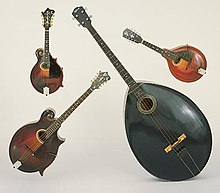Mandoloncello
The mandoloncello , also called mandocello , is a plucked instrument from the mandolin family . It has 8 strings that are tuned to fifths for double choirs . It is larger than a mandolin and tuned lower in CC – GG-dd – aa. The mood of the mandoloncello corresponds to the cello of the violin family.
Design
The mandoloncello has a similar structure to the mandolin. The back of the instrument can have the round shape known for the mandolin, or it can be flat. The flat back construction goes back to the designs of Gibson Guitar Corporation , which made it popular in the USA in the early 20th century. The mandoloncello is usually strung with 4 pairs of strings, which are tuned in CC-GG-dd-aa. Usually his voice is notated in the bass clef. In German sheet music editions, however, often also in the treble clef that octaves downwards . Due to the enormous thickness of the C-string, some mandoloncello players remove one of these to prevent rattling and thus to be able to play fortissimo more comfortably . The 10-string mandoloncello receives an additional pair of E strings, so that the tuning is now CC – GG – dd – aa – e'e '. Such a mandoloncello is also known as liuto cantabile or liuto moderno , but technically it remains a mandoloncello.
Style of play
The mandoloncello with a round back is mainly used as a bass instrument in mandolin orchestras and mandolin quartets. It is also used as a solo instrument in classical works that were originally composed for a cello. Furthermore Raffaele Calace composed some pieces especially for the liuto cantabile in the early 20th century . The mandoloncello also plays a role in modern folk, such as bluegrass , in Celtic or Italian folk music. The mandoloncello with a flat back is typically used here. The most important mandocellists are Bill Monroe and Raffaele Calace. The latter is said to have perfected the design of the instrument.
In the first half of the 20th century, the mandoloncello was part of the standard instrumentation of a plucked orchestra. However, its range resembled that of a common guitar , which the mandoloncello gradually ousted from German plucked orchestras in the second half of the 20th century. In Italy or France, however, the mandoloncello is still in use. The mandoloncello is also used in modern rock music. For example, Bon Jovi guitarist Richie Sambora used a mandoloncello in the song "Lay Your Hands on Me" for the new acoustic recordings collected on This Left Feels Right .
